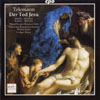Telemann Der Tod Jesu
Another Telemann rarity – though already a duplicate in the catalogue – given a stylish performance under Ludger Remy’s direction
View record and artist detailsRecord and Artist Details
Composer or Director: Georg Philipp Telemann
Label: CPO
Magazine Review Date: 1/2001
Media Format: CD or Download
Media Runtime: 76
Mastering:
DDD
Catalogue Number: CPO999720-2

Tracks:
| Composition | Artist Credit |
|---|---|
| (Der) Tod Jesu |
Georg Philipp Telemann, Composer
Britta Schwarz, Contralto (Female alto) Dorothee Mields, Soprano Georg Philipp Telemann, Composer Jan Kobow, Tenor Klaus Mertens, Bass Ludger Rémy, Organ Magdeburg Chamber Choir Michaelstein Telemann Chamber Orchestra |
Author: Lindsay Kemp
The passion oratorio Der Tod Jesu, to words by Klopstock’s friend Karl Wilhelm Ramler, is acknowledged as one of the finest works to have come from the pen of Carl Heinrich Graun, a piece which in Germany used to be as popular as Messiah was in England. Currently there are no recordings of it in the catalogue, which is a pity because here now is a second version of Telemann’s setting of the same text, and the two oratorios would have made an interesting comparison – all the more so since Graun himself has been posited as the person who sent Telemann a copy of the libretto, perhaps with the intention of provoking discussion. He probably did not expect, however, that Telemann would beat him to it and perform his own Der Tod Jesu in Hamburg in March 1755, a week before Graun’s was premiered in Berlin.
Telemann’s work is certainly a worthwhile one in its own right. Perhaps no other area of this composer’s output is as appealing as the music he produced in later life, when he was responding both to the newer developments in musical style represented by the likes of Graun and C P E Bach, and to the younger generation of German sentimental poets, of whom Ramler was one. This is not a narrative passion for church use in the style of Bach; chorales are present, but there is no Evangelist, no Gospel text and no crowd choruses. Rather, we have a concert oratorio in which events are depicted as if seen from afar through the eyes of helpless observers. This is done through the choruses and arias (the latter often rather folky, unassuming and perhaps in places inappropriately jolly), but most tellingly in the lengthy recitatives (many of them with orchestral accompaniment) whose disarmingly straightforward effectiveness has more than a little of the flavour of the descriptive recitatives in Haydn’s oratorios. In short, this is a work which is never less than attractive, but which in its best moments shows a moving earnestness and sobriety which not many would be quick to associate with its composer. Play the opening orchestra ‘Lamento’ to an innocent listener, and see if they guess Telemann as its author.
The performance does the work full justice. I had not previously encountered many of the names on the list here, but although special mention must go to Klaus Mertens, the other soloists, the orchestra and (to a slightly lesser extent) the choir for the most part acquit themselves well in an interpretation which seems to do the right things in the right places, and do them with an accomplished neatness and good taste that I am sure Telemann would have appreciated. The recorded sound, too, is restrained and sympathetic. Yet another pleasant Telemann surprise.'
Telemann’s work is certainly a worthwhile one in its own right. Perhaps no other area of this composer’s output is as appealing as the music he produced in later life, when he was responding both to the newer developments in musical style represented by the likes of Graun and C P E Bach, and to the younger generation of German sentimental poets, of whom Ramler was one. This is not a narrative passion for church use in the style of Bach; chorales are present, but there is no Evangelist, no Gospel text and no crowd choruses. Rather, we have a concert oratorio in which events are depicted as if seen from afar through the eyes of helpless observers. This is done through the choruses and arias (the latter often rather folky, unassuming and perhaps in places inappropriately jolly), but most tellingly in the lengthy recitatives (many of them with orchestral accompaniment) whose disarmingly straightforward effectiveness has more than a little of the flavour of the descriptive recitatives in Haydn’s oratorios. In short, this is a work which is never less than attractive, but which in its best moments shows a moving earnestness and sobriety which not many would be quick to associate with its composer. Play the opening orchestra ‘Lamento’ to an innocent listener, and see if they guess Telemann as its author.
The performance does the work full justice. I had not previously encountered many of the names on the list here, but although special mention must go to Klaus Mertens, the other soloists, the orchestra and (to a slightly lesser extent) the choir for the most part acquit themselves well in an interpretation which seems to do the right things in the right places, and do them with an accomplished neatness and good taste that I am sure Telemann would have appreciated. The recorded sound, too, is restrained and sympathetic. Yet another pleasant Telemann surprise.'
Discover the world's largest classical music catalogue with Presto Music.

Gramophone Digital Club
- Digital Edition
- Digital Archive
- Reviews Database
- Full website access
From £8.75 / month
Subscribe
Gramophone Full Club
- Print Edition
- Digital Edition
- Digital Archive
- Reviews Database
- Full website access
From £11.00 / month
Subscribe
If you are a library, university or other organisation that would be interested in an institutional subscription to Gramophone please click here for further information.




